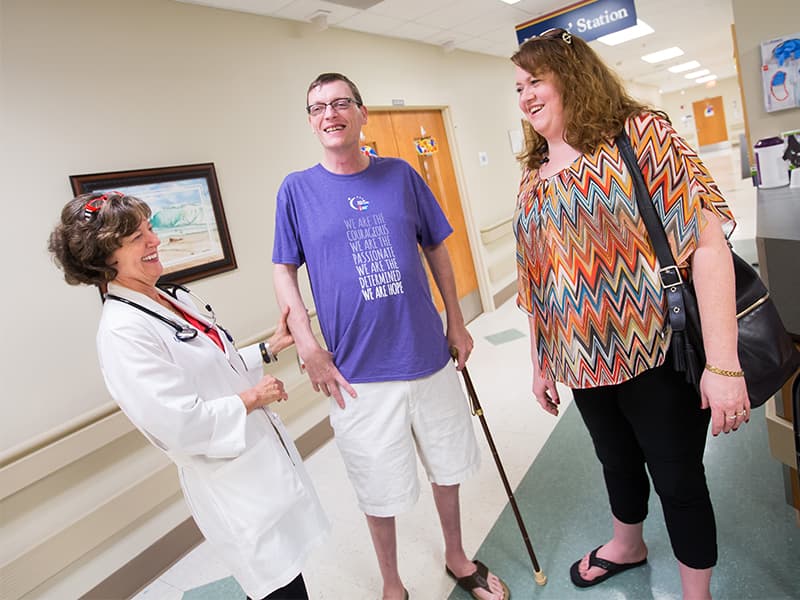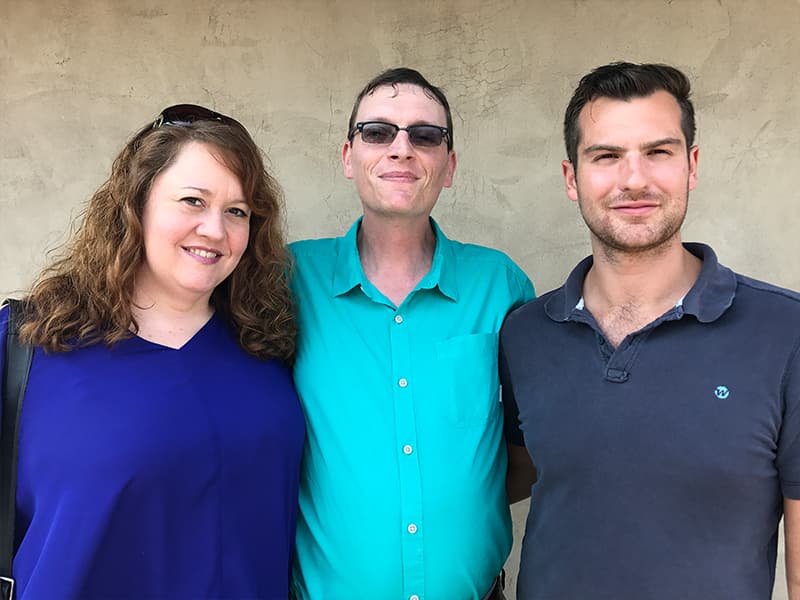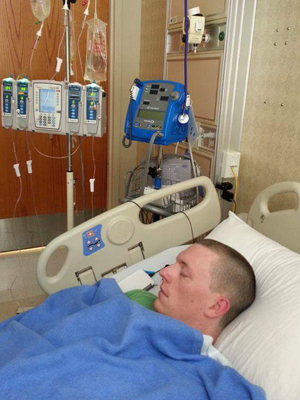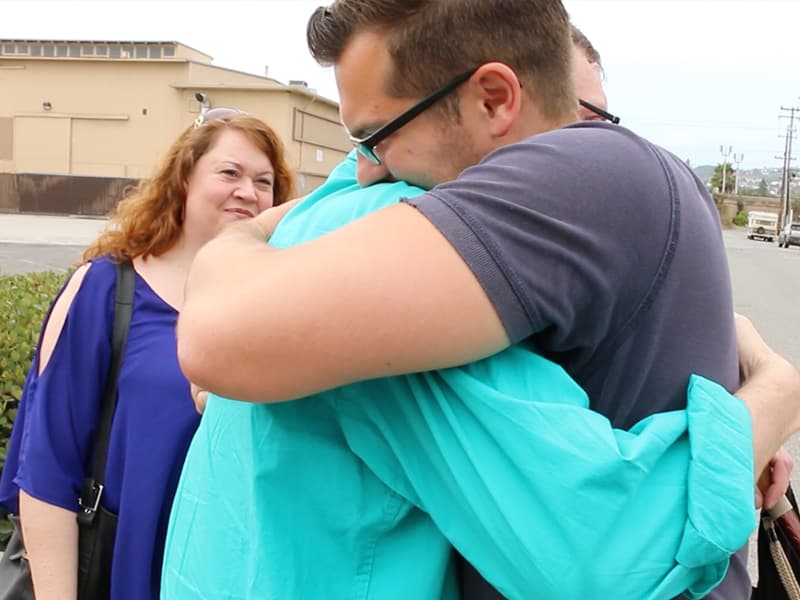Bone marrow recipient encourages registry donors

Alex Kimura’s quest to help her sister saved Caleb Rich’s life.
Now the Starkville resident hopes the story of his stem cell transplant, a brief element in a documentary Alex is producing, will help others.
In 2012, as Alex, her sister Sam Kimura, and their best friend Taylor Shorten, sought a match for Sam, they registered the donor who would be a match for Rich. Rich received his transplant Sept. 25, 2013, becoming one of more than 400 people who have matched through the sister’s efforts to add 50,000 donors to DKMS, an international marrow and stem cell registry.
In mid-August, as part of the trio’s documentary, “In My Bones,” Caleb met his donor, Jon Torrey, face to face in California, with cameras present.
“We shook hands and hugged. I cried a little and told him ‘thank you isn’t enough,’” Rich said recently during a visit to the University of Mississippi Medical Center Bone Marrow Transplant unit, a place he called home for about a month during his transplant.
Torrey calls the meeting simple. “He and I have exchanged a few emails and Facebook messages over the years. It was as if I was meeting an old friend I hadn’t seen in a while. We dropped into conversation naturally.”

The Kimura sisters started registering donors in 2011, soon after Sam was diagnosed with aplastic anemia, a condition that occurs when the body’s bone marrow is damaged and unable to produce healthy blood cells. A bone marrow or stem cell transplant offers a potential cure. They started a non-profit, Sharing America’s Marrow, or SAM, in 2014.
Sam currently is in remission but may need a match one day. While Sam’s perfect match is yet to be found, SAM the non-profit carried its quest nationwide in 2015 with a stop in all 50 states to register donors. By fall 2017, they had garnered more than 24,300 new registrations and some 400 matches.
As the Kimuras and Shorten traveled, they filmed their encounters. “In My Bones” documents Sam’s life journey, and “shares stories of people we met along the way,” Alex said. The documentary also tries to dispel myths associated with becoming a donor.
“Hopefully, it will raise a lot of awareness,” Alex said. “In My Bones” is scheduled for release nationwide in early 2018 at several film festivals.

The DKMS Registry, established in 1991 in Germany, spread worldwide in 2004. Locally, more Mississippians are familiar with Be The Match, the bone marrow and stem cell registry that is part of the National Marrow Donor Program. DKMS and the NMDP collaborate to help patients.
Rich’s journey started in May, 2012, with what he thought was the flu. Rich said bloodwork had his doctor delivering a different message: “’I may be wrong, but I’m quite certain you have some form of leukemia,’” Rich recalls him saying.
Rich said he underwent several weeks of inpatient treatment at North Mississippi Medical Center and received his final round of chemo in March 2013. Because of a genetic mutation, he was at a higher risk for a relapse. “A transplant would give me close to an 80 percent chance of long-term survival,” he said. By mid-summer, he had a match and the transplant occurred at UMMC.
Patients and staff on the UMMC Cancer Institute’s BMT unit become family, said Melissa Rich, Caleb’s wife. Their recent visit was rife with hugs. First there was Laken Miller, one of Caleb’s nurses who is now a nurse practitioner in Hattiesburg, who drove up to see him, and then Dr. Carolyn Bigelow, his hematologist/oncologist, followed by nurses and staff on the BMT floor.
Bigelow was casting an appraising glance at her patient during his follow-up appointment that day.
“He was an awesome patient,” she said.
“I was boring,” Caleb replied.
Bigelow laughed. “Boring is great. He’s been great about coming to his appointments and taking his medications.”
“Most of it,” Caleb said, garnering a frown, narrowed eyes and head shake from Bigelow. But his California meeting was the big topic.
DKMS allows donors and recipients to connect after a year if both are willing. Torrey and Caleb connected via Facebook, phone and email. Until Alex sought to film a donor and recipient meeting, they had never met face to face.
“It was bigger deal to me than it was to him,” Caleb said. “He’s the reason I’m alive. He signed up and answered the call. I got his stem cells. He didn’t feel like he’d done anything worthy of this adoration from me and my family and friends.”
Torrey said signing up for the registry was easy. He met Alex and Sam in 2012 at a conference. “They made the process so frictionless that it was impossible to say no to the request.”
He had motive, too. “I have two relatives that lost the fight to cancer, lung in both cases, so the opportunity to directly help someone was attractive.”
The stem cell donation process was simple. He received shots in the days preceding the donation to increase his stem cells. The cells were removed through apheresis: blood is withdrawn from one arm, filtered to remove the stem cells and replaced in the other arm. The stem cells are transported to the recipient.

Caleb and Melissa said the meeting was more than they expected. Alex arranged for the couple to travel to Redwood City, south of San Francisco, near Torrey’s workplace. They stood with their backs to Torrey as he approached. “When he was 3 feet from us, he called my name,” Caleb said. “You may not think it’s a big deal, but I do.’”
Today, five years post-transplant, Caleb and Melissa work to repay those who helped save Caleb’s life.
When Caleb was diagnosed, he underwent a combination therapy that was relatively new, one birthed by research funded by the American Cancer Society. Now he helps lead the Oktibbeha County Relay for Life, partly in gratitude for the work ACS helped fund and partly in memory of transplant patients who didn’t make it.
This past year, the Relay team planned to raise $65,000, but raised almost $90,000. “The enthusiasm was higher,” Caleb said. “I’ll do anything to raise awareness. It just gives back to my community.”
Torrey said he’d donate again. “Donating is the easiest way to directly save a life with an incredibly low barrier to entry.”
While it’s unusual for a donor to ask to remain on the registry, he has. “I could still proceed if another match is found,” he said. “You don’t turn down that opportunity.”
Keep tabs on the documentary and find out how to sign up for the DKMS Registry at http://sharingamericasmarrow.com/
Sign up for Be the Match, a part of the National Marrow Donor Program, https://bethematch.org/


